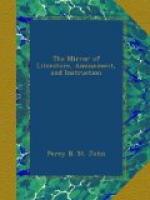The male is generally two or three inches shorter than the female; the white on the head, neck, and tail being more tinged with yellowish, and its whole appearance less formidable; the brown plumage is also lighter, and the bird itself less daring than the female, a circumstance common to almost all birds of prey.
The eagle is said to live to a great age—sixty, eighty, and, as some assert, one hundred years. This circumstance is remarkable, when we consider the seeming intemperate habits of the bird. Sometimes fasting, through necessity, for several days, and at other times gorging itself with animal food till its craw swells out the plumage of that part, forming a large protuberance on the breast. This, however, is its natural food, and for these habits its whole organization is particularly adapted. It has not, like men, invented rich wines, ardent spirits, and a thousand artificial poisons, in the form of soups, sauces, and sweetmeats. Its food is simple, it indulges freely, uses great exercise, breathes the purest air, is healthy, vigorous, and long lived. The lords of the creation themselves might derive some useful hints from these facts, were they not already, in general, too wise, or too proud, to learn from their inferiors, the fowls of the air and beasts of the field.
* * * * *
NOTES OF A READER.
THE LATE MRS. SIDDONS.
The subsequent account of Mrs. Siddons, nearly fifty years since, will perhaps give the reader a better outline of that “Queen of Tragedy” than any that has since appeared. We ought to mention that it is quoted from Mr. Boaden’s Memoirs, and was written on the appearance of Mrs. Siddons in the character of Isabella, for the first time in London, October 10, 1782. Mr. Boaden thus introduces the quotation, in vol. i. of his work:—
As the person of our great actress has undergone some change, and her features by time became stronger, I should find it difficult now to describe her accurately by memory, as she stood before the audience on the night of the 10th of October. I am relieved from this difficulty by an account of her written at the time. I shall change only a few of the expressions then used, more from a feeling as to composition than alteration as to sentiment.




